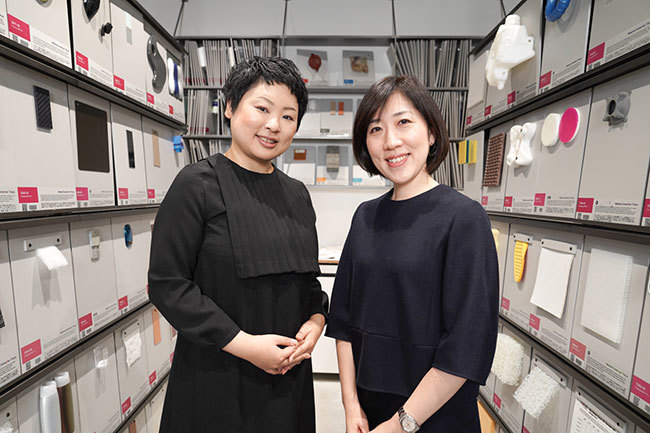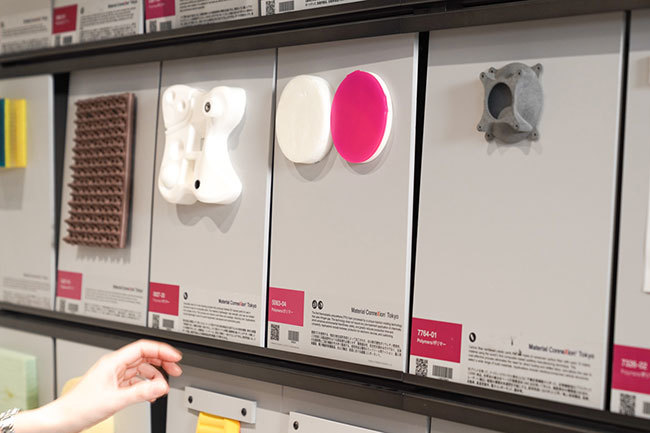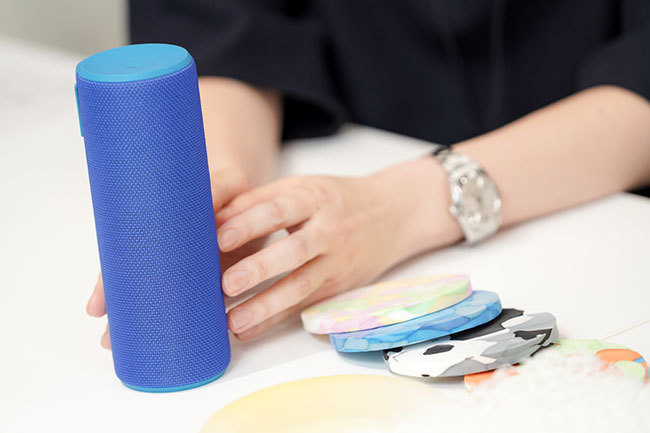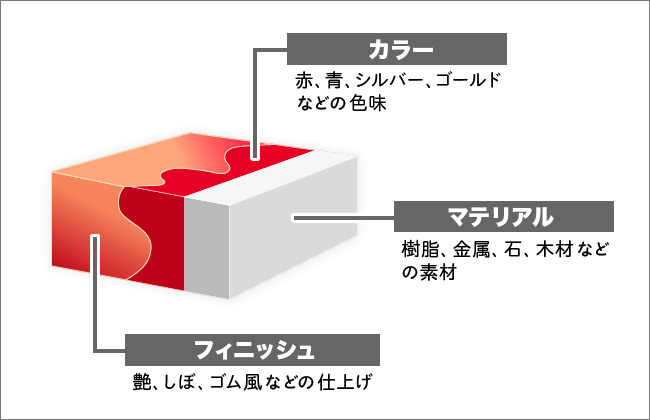
Material Connection Tokyo Representative Kumiko Yoshikawa (right) and Dentsu Inc. CDC's Mineko Hotta. At the "Material Library" in Tokyo
In December 2018, Dentsu Inc. announced a collaboration with Material ConneXion Tokyo. Material ConneXion operates material libraries worldwide and provides material-driven consulting. Leveraging each other's strengths, they will contribute to new product development for various companies.
The goal of this collaboration is "Material Experience." It aims to provide unprecedented product experiences and create new scenarios by leveraging the sensory values and social contributions inherent in materials themselves, such as their "tactile feel" and "low environmental impact."
Kumiko Yoshikawa, Representative Director of M-Crossing, which operates Material Connection Tokyo, and Mineko Hotta, who leads DENTSU DESIGN FIRM—Dentsu Inc.'s cross-functional organization focused on the product domain—discussed this initiative.
The Growing Importance of Materials in an Era of Product Differentiation
Hotta: Today, I'd like to discuss why we chose to collaborate and the importance of the "Material Experience" both companies aim to achieve. But seriously, this library displays an incredible variety of materials!

The Material Library displays the latest materials from around the world across eight categories, including "Resin," "Metal," and "Natural Materials." It attracts numerous corporate planners and product developers.
Yoshikawa: The library permanently displays 2,400 materials and manages a database searchable for information on approximately 7,500 materials. Our concept is a "cross-industry collection," and we use these samples to provide what you might call "material-driven consulting."
Our primary clients are product manufacturers and apparel makers seeking materials for their own products. Recently, more companies are exploring incorporating materials used in completely different industries to create new value. Conversely, we also receive many inquiries from material manufacturers who develop and supply these materials.
Hotta: The importance of materials has definitely grown as a recent trend. Historically, products differentiated themselves and added value through elements like color, material, and finish. However, commoditization is advancing across all industries, making it increasingly difficult to differentiate products solely based on appearance or function. In this environment, materials have become one key means of creating original value.
Yoshikawa: Many industries have moved beyond simply upgrading performance and are now shifting the very concept of the product itself to the next stage. Take automobiles, for example. As the concept of the car itself changes with features like "autonomous driving," the interior might start resembling a home. Furthermore, if accidents and collisions can be avoided, the exterior might not need to use such robust metals. With the accelerating pace of societal and technological innovation, the materials traditionally used in automobiles are becoming insufficient.
Hotta: Another major shift is the heightened social and environmental awareness, exemplified by the SDGs (United Nations Sustainable Development Goals). In an era demanding sustainability from companies, material selection must be considered from the perspective of "reducing environmental impact." The recent topic of coffee chains using "non-plastic straws" is a prime example symbolizing this change related to materials and the SDGs.
Yoshikawa: One U.S. beauty manufacturer used wood chips, typically employed in building materials, for the caps and packaging of their new lipstick product. This company already prioritized environmentally conscious ingredients in their beauty products, and this move further communicated that stance in a tangible way. It's also a great example of a product inspired by materials used in a different industry.
Why would a materials consulting firm and Dentsu Inc. collaborate?
Hotta: What we aim to provide companies through this collaboration is the experiential value materials bring to users—the "Material Experience."
Materials connect not just visually, but holistically through touch, scent, and other senses to evoke feelings like "comfort" and "reassurance." Essentially, by starting with the material itself to create products that trigger emotions and sensations, we aim to provide new value—like creating unprecedented experiences and scenarios. It's about harnessing the inherent power of the material, rather than relying solely on design. This portable speaker is a clear example, right?

An example of a product Material Connection Tokyo consulted on. It proposes a "carry-it-with-you" style for speakers typically fixed in place at home. It feels soft and pleasant to the touch.
Yoshikawa: This is a Bluetooth speaker designed to connect with smartphones and other devices, specifically intended for portability. While mesh materials for speakers often use metals like perforated metal, considering that you hold it in your hand—meaning it touches your skin—a softer, more comfortable material is preferable. Also, if you're carrying it around, you'd naturally want something more colorful and fashionable.
With that in mind, we proposed this mesh fabric and elastomer resin. The mesh material, used for office chair upholstery, offers abrasion resistance and strength. The exterior is molded from an elastomer resin with a silky-smooth feel, similar to silicone. The result is a soft texture, waterproofing, and vibrant color options. This fundamentally changes how it's used. You can put it in your bag or take it outdoors to the beach or mountains. By changing the texture and feel through the materials, the experience the product delivers also transformed.
Hotta: That's exactly what we mean by material experience! Through our future collaboration, I hope we can create many more such new values. Could you also tell us why you decided to collaborate with Dentsu Inc. this time?
Yoshikawa: While we excel in material knowledge, we've felt that knowing too much about materials sometimes hinders our ability to fully convey their appeal. Especially since the value of materials often can't be grasped just by looking at them. What's new about it? What meaning does this material hold? We want to express that intuitively through visuals and copy. We believed partnering with Dentsu Inc., who excels in this area, would allow us to complement each other.
Moreover, precisely because our backgrounds differ, we believe we can create and communicate new value together in ways never attempted before.
Conveying the value of materials and the company's vision—things not immediately apparent
Yoshikawa: For example, the cup Mr. Hotta is holding now contains natural fibers mixed with resin, making it environmentally friendly. When molded, the mixture ratio varies slightly for each piece, resulting in unique patterns for every item.
Historically, manufacturers tended to avoid products that couldn't be produced uniformly due to quality control concerns. But the tide is shifting. Consumers are starting to embrace products made from sustainable materials like this, each with its own unique character. It's crucial to figure out how to communicate the sustainability and unique characteristics of these materials to society – aspects that aren't immediately apparent from a photo.

Products hybridizing natural materials are currently one direction attracting attention from various companies.
Hotta: This cup's material carries a story and the company's vision, right? We want to focus our advertising communication efforts on effectively translating that into value and conveying it.
Yoshikawa: In many companies, product development and advertising teams are separate. For example, during development, firms like Material Connection propose products starting from the material, and advertising agencies come in during the communication phase. But precisely because of this, the "how to communicate" aspect often felt like an afterthought.
Hotta: In contrast, this collaboration establishes a structure where both companies work as one team from the consulting and product development stages. By bringing in Dentsu Inc., the communication experts, the "essential strengths of the product and material" are clarified early on and shared as key messages with everyone. These key messages then directly inform the advertising communication, leading to more targeted and effective expressions.
Yoshikawa: In terms of how we communicate, the target isn't just consumers and society, but also within the company itself. For example, when the development department comes up with a product idea using a new material, how do they convey its value internally? This is also a current communication challenge.
On the other hand, for material manufacturers providing the materials, how do they promote new materials? We're no longer in an era where simply showing a material's "functionality" with numbers is sufficient. Communicating the unprecedented added value that material brings also requires communication know-how.
"Beetle boards" become coasters. We also want to propose new ways to use materials.
Hotta: While new materials are important, even long-established materials can gain entirely new value through proposals for novel uses or scenarios. Dentsu Inc.'s creators possess the ability to generate such ideas. By engaging in product development rather than just advertising, we also aim to expand the scope of advertising creators' work.
Yoshikawa: Speaking of utilizing traditional materials, this coaster (the tea coaster provided to the interviewers) is actually made from the same material as the "beet board" (polyethylene foam). Touching it evokes a nostalgic feeling – a material experience that "brings back memories," I think (laughs).
We aim to pursue product and material applications where the power of advertising communication helps people imagine the "experience," and then, by touching the actual object before them, they can clearly feel, "Ah, this is what it means." It would be great if we could realize that.
Hotta: Looking at various Dentsu Inc. surveys, the user insight "I want to choose environmentally conscious products" is growing stronger, and the significance of materials will only increase going forward. I believe the material experiences we provide—moving beyond the stage of "surface decoration" like color, material, and finish—have the power to elevate Japanese manufacturing to the next level. Thank you very much today!

Material Connection Tokyo suggests diverse material applications to companies, such as coasters made from surfboard material (foreground).













